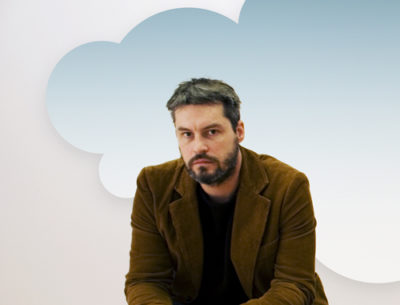Professor encourages people to re-envision surroundings, creative disciplines
Thanks to 24-hour TV networks, up-to-the-minute blog postings, Tweets and a variety of other fast-paced media influences, people can easily become inundated with information. But instead of retreating from the media onslaught, a UMKC professor’s art exhibition encourages people to re-envision or re-think their surroundings.
“Intermissions” – an installation of video, sound and photographs by Barry Anderson, associate professor in the UMKC College of Arts and Sciences‘ Department of Art and Art History – appeared at 13 locations throughout Syracuse, N.Y. in the fall of 2009 and was published as a 48-page book in September. Sponsored by non-profit organization Light Work and Syracuse University, the project offers a welcomed artistic interruption to daily life in a time of economic uncertainty and other societal stresses.

Professor Anderson recently finished this print to benefit KVC Behavioral HealthCare. Additional works can be found at Anderson’s Web site, www.barryanderson.com.
To reach a broad audience and bring art into the community, “Intermissions” works were projected onto windows and buildings, plastered on billboards and presented on a local TV channel. Featuring purple skies, abstract worlds filled with bubbles and colorful fragments of semi-familiar scenes, the pieces created good-natured, introspective scenes that contrasted the busy settings.
“I want to reach people as they go through their day-to-day lives,” Anderson said. “Why? Are people not pausing enough today? Are we too fast-paced to look at an art exhibition?”
To create a historical counterpoint to the current era, Anderson created a majority of video animations from appropriated American advertising images of the 1950s, 1960s and 1970s. While the images present a façade of “shiny, happy people,” evolving economic, social and ethnic factors were beginning to erode the U.S. cultural homogeny.
“There was a civil rights battle in the South and the Beat Generation was trying to tear down the image of shiny, happy people in suburban homes,” Anderson said. “But so little of that was referenced in the advertising. It’s important to not be duped, and to really know what you’re seeing.”
Through “Intermissions,” Anderson hopes people will re-think advertising images from the 1950s, 1960s and 1970s – and ultimately re-think their everyday surroundings.
“Pablo Picasso said ‘Art is a lie that tells the truth,’ and I’m using fake images from advertising to tell the truth,” Anderson said.
Art 2.0
In addition to encouraging people to re-think their surroundings, Anderson encourages students to re-think traditional artistic boundaries. Rather than focusing solely on one artistic discipline, such as painting or video, today’s art students often combine several disciplines.
“The disciplines keep intersecting more and more,” Anderson said. “Technology has affected artwork, and it’s difficult to find boundaries. A lot of artists don’t care about boundaries anymore.”
Anderson’s Introduction to Computer Multimedia course, for example, incorporates three disciplines – digital photography, multimedia illustration and design. His Computer Multimedia I course incorporates two disciplines – video and motion design.
Students from the Department of Art and Art History also regularly take classes from the Film and Media Arts division of Communication Studies and vice versa. For example, art students accustomed to animating in a non-narrative sense are encouraged to take Film and Media Arts courses that teach them to animate in a narrative sense.
Anderson holds an MFA from Indiana University. His work has appeared in solo and group exhibitions throughout the country, as well as in Thailand, South America, Russia and the UK. Recent exhibition venues include the Nerman Museum of Contemporary Art in Overland Park, Kan.; Milo Gallery in Los Angeles; White Flag Projects in St. Louis; Marty Walker Gallery in Dallas; Salina Art Center in Salina, Kan.; Schopf Gallery on Lake in Chicago; Dam Stuhltrager in Brooklyn, N.Y.; and the Centre for Contemporary Photography in Toronto.

